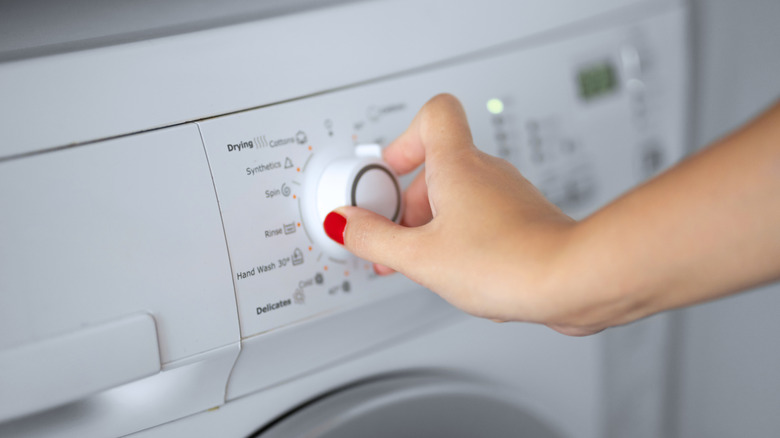How The Wrong Temperature Can Leave Stains On Your Clean Laundry
If you've ever pulled your clothes out of the washer and found odd white marks or stubborn stains that weren't there before, the culprit could be the water temperature you chose. Yep — using the wrong temperature setting on your washing machine can actually leave stains on your clothing and possibly even permanently damage the fabric. Powder detergents, for example, often don't dissolve fully in cold water, especially during quick wash cycles. Instead of rinsing clean, they leave behind a white residue that looks a lot like a stain. That defeats the whole point of doing laundry, right? It's one of many laundry mistakes that will make stains way worse — once that residue sets in, it can be difficult to remove without rewashing. For better results, consider switching to liquid detergent or using warm water for heavier loads like towels and jeans.
Water temperature also affects how stains react. Cold water won't lift greasy or oily messes effectively, and hot water can "cook" protein-based stains like blood or sweat into the fabric. That's why choosing the right temperature matters for more than just getting your laundry clean — it's essential for keeping it clean. If you're aiming for that fresh-out-of-the-laundry feel, matching water temperature to the type of fabric and soil level is one of the best laundry hacks that will leave your clothes smelling fresh and looking clean. Small adjustments can prevent damage, reduce rewash frustration, and help your laundry routine actually work for you.
Using the correct temperature for truly clean laundry
Choosing the wrong settings on your washer can ruin your clothes and your day. Using the wrong temperature can stain clean laundry, fade colors, and even lock in odors. Temperature isn't just a preference; it's a key player in how effective your wash cycle really is. Cold water (60 to 80 degrees Fahrenheit) is best for delicates, dark colors, and lightly soiled clothes. It saves energy and helps prevent shrinking and fading. But here's the catch: cold water isn't always great at breaking down oils or fully dissolving powder detergent. That's why your gym clothes and towels may come out with a funky smell or a cloudy residue.
Warm water (90 to 110 degrees Fahrenheit) is the happy medium. It works well for synthetics, light bedding, jeans, and moderately dirty loads. It dissolves detergent better than cold and still protects fabric. Washing towels, underwear, or kids' clothes in warm water is the way to go.
Hot water (120 degrees Fahrenheit and up) is powerful for whites, heavily soiled work clothes, and linens, but it's not a cure-all. What everyone gets wrong when doing laundry is assuming hot water will get everything extra clean. It can actually make protein stains like blood or baby formula permanent, making them almost impossible to remove. No matter the temp, always sort by fabric and soil level, check labels, and don't overload the drum.
